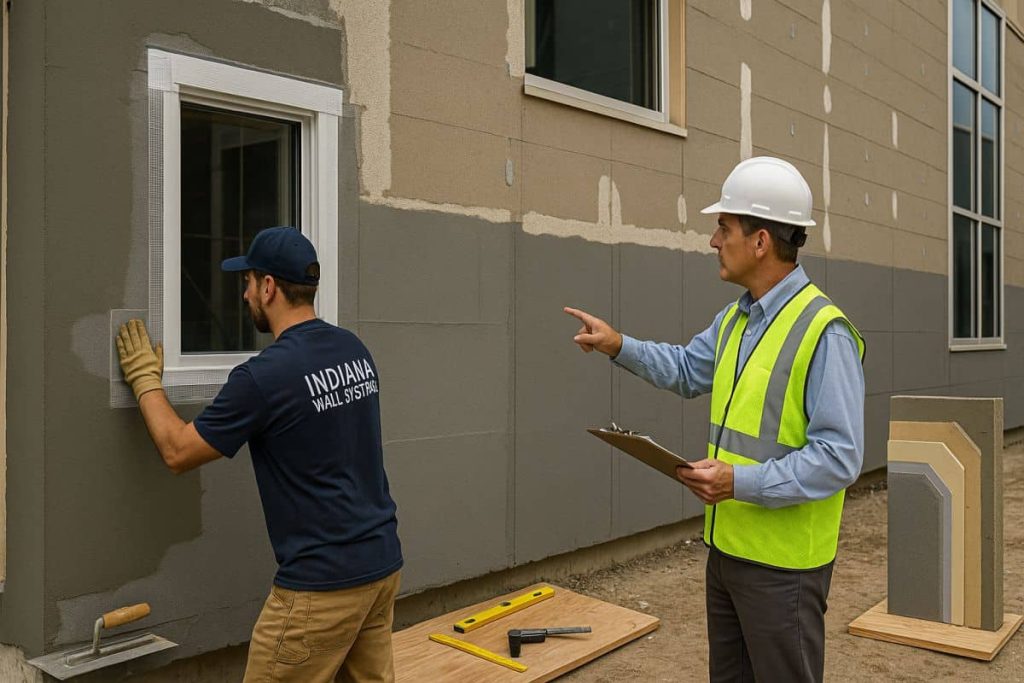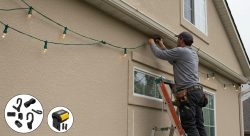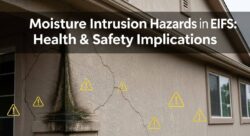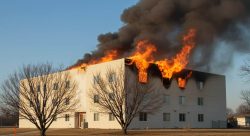Stay Code-Ready, Pass Inspections, And Protect Your EIFS Investment
Getting EIFS code compliance wrong can cost you thousands. As someone who’s been in the Exterior Insulation and Finish System business for over two decades, I’ve seen too many projects fail inspections, face expensive retrofits, or worse—create safety hazards.
At Indiana Wall Systems, we’ve completed over 1,200 EIFS projects across Indiana, Kentucky, Ohio, Tennessee, Michigan, and Illinois. Through all these installations, I’ve learned that building code requirements aren’t just paperwork—they’re your blueprint for success.
Let me share what I wish every homeowner, contractor, and property manager knew about EIFS compliance before starting their project.
Key Takeaways
- EIFS with drainage systems must achieve 90 percent drainage efficiency when tested per ASTM E2273
- The 2021 International Building Code requires specific fire-resistance ratings for different building types
- Third-party inspections are mandatory for most commercial EIFS installations
- Plan-review approval before installation can prevent costly rework
- Moisture management layers and proper flashing details are non-negotiable for code compliance
Understanding Current EIFS Code Requirements

The International Building Code and International Residential Code have evolved significantly since the early days of EIFS. Today’s current code requirements focus heavily on moisture management and fire safety.
What’s Changed in the 2021 Codes
The 2021 International Building Code introduced stricter requirements for exterior wall assemblies. These changes weren’t arbitrary—they came from decades of field data showing where EIFS installations succeed or fail.
For residential applications, the International Residential Code now requires:
- Water-resistive barrier installation behind all EIFS systems
- Drainage capabilities for EIFS applied over framed walls
- Specific flashing installation details at all penetrations
- Vapor permeability rating documentation for climate compatibility
Commercial projects face even tighter scrutiny. The IBC mandates:
- NFPA 285 façade fire test compliance for buildings over three stories
- Special-inspections requirement during installation
- Quality-assurance program documentation
- Field water testing before final approval
ASTM Standards You Must Know
ASTM testing protocols form the backbone of EIFS compliance. Here are the critical ones:
ASTM E2273 measures drainage efficiency. Your EIFS system must demonstrate minimum drainage efficiency of 90 percent when tested. This isn’t a suggestion—it’s a hard requirement for EIFS with drainage systems.
ASTM E2570 evaluates overall structural performance of EIFS assemblies under various conditions. This test ensures your system can handle wind loads, thermal cycling, and moisture exposure.
ASTM E330 tests wind-load resistance. With Indiana’s unpredictable weather, this standard protects your investment from storm damage.
Jeff Johnson, our CEO, puts it simply: “These standards exist because field failures taught us hard lessons. Follow them, and your EIFS will perform for decades.”
EIFS Drainage Requirements: The 90% Rule
Let’s talk about the big one—drainage efficiency. Every EIFS with drainage system must achieve average minimum drainage efficiency of 90 percent when tested in accordance with ASTM E2273.
Why 90% Matters
Water that doesn’t drain becomes trapped water. Trapped water leads to:
- Insulation board deterioration
- Structural damage
- Mold growth
- System failure
💧 ASTM E2273 Drainage Efficiency Standards
Drainage Efficiency Scale
ASTM E2273 Requirement: All EIFS with drainage systems must achieve minimum 90% drainage efficiency when tested. Indiana Wall Systems consistently achieves 95%+ efficiency with proven installation methods.
We’ve remediated dozens of older EIFS installations that lacked proper drainage. The repair costs always exceed what proper installation would have cost initially.
Achieving Compliance
Drainage-plane design requires three components:
- Water-resistive barrier behind the insulation board
- Drainage channels or cavities for water movement
- Weep systems at the base for water exit
The backwrapping technique at window and door openings creates continuous drainage paths. This detail alone prevents most moisture-related failures we encounter.
Testing and Documentation
Field water testing verifies your drainage system works as designed. We perform this test on every commercial project and recommend it for high-end residential work.
The test involves:
- Water application at specified rates
- Collection and measurement of drainage
- Documentation for permit approval
Fire Safety and NFPA Compliance
Fire safety requirements vary dramatically based on building type and height. Understanding these requirements prevents expensive design changes late in the project.
NFPA 285 Testing
Buildings over three stories typically require NFPA 285 façade fire test compliance. This full-scale test evaluates how fire spreads across the entire wall assembly.
Not all EIFS systems pass NFPA 285. Using a non-compliant system means:
- Failed plan review
- Project delays
- Complete system redesign
- Thousands in additional costs
🔥 NFPA Fire Testing Requirements by Building Height
✅ ASTM E84 compliance
❌ NFPA 285 not required
⚠️ Full-scale facade testing
⚠️ Third-party inspection
Critical Note: NFPA 285 testing is expensive ($15,000-30,000) and time-consuming. Plan early and verify your system’s compliance before specification.
NFPA 268 and Interior Applications
For EIFS interior applications, NFPA 268 ignition test requirements apply. This test measures:
- Flame-spread index
- Smoke-development index
These ratings determine where you can install EIFS indoors.
Combustible Cladding Regulations
Recent combustible-cladding regulations affect material selection. Some foam insulation boards now face restrictions on certain building types.
We stay current with these changing regulations through EIMA industry guidelines and regular training. This knowledge protects our clients from compliance issues.
Structural Performance Standards
EIFS must meet specific structural performance criteria. These requirements ensure your system withstands environmental loads without failure.
Wind Load Requirements
Wind-load resistance testing per ASTM E330 establishes design pressures your EIFS can handle. Indiana’s weather patterns demand robust wind resistance.
Key factors include:
- Building height and exposure
- Local wind speed data
- Deflection criteria L/240 for substrate limitations
- Impact-resistance classification for vulnerable areas
Attachment Methods
The choice between adhesive vs. mechanical fastening affects structural performance. Each method requires specific substrate preparation and inspection protocols.
Mechanical fastening provides superior wind resistance but requires careful detailing to maintain thermal performance. Adhesive attachment offers thermal advantages but demands perfect substrate conditions.
Substrate Requirements
Sheathing substrate preparation directly impacts structural performance. The substrate must:
- Meet flatness tolerances
- Provide adequate attachment strength
- Resist moisture penetration
- Maintain dimensional stability
We’ve seen installations fail because contractors skipped proper substrate evaluation. Don’t let this happen to your project.
Moisture Management and Thermal Performance
Moisture management and thermal performance work together in successful EIFS installations. Getting either wrong compromises both.
Building Envelope Integration
Your EIFS connects to other building envelope components. These connections must maintain:
- Air-barrier continuity
- Thermal-bridging reduction
- Condensation-control strategy
We design these connections during the planning phase, not as afterthoughts during installation.
Climate Considerations
Indiana’s climate creates specific challenges:
- Dew-point calculation for winter conditions
- Vapor permeability rating selection
- Thermal resistance requirements per ASHRAE 90.1
The wrong vapor permeability can trap moisture inside wall assemblies. We select materials based on detailed climate analysis, not guesswork.
Continuous Insulation Requirements
Energy code compliance often requires continuous insulation effectiveness. EIFS excels here, but details matter.
Thermal-bridging reduction requires attention to:
- Window and door connections
- Balcony and deck attachments
- Structural penetrations
- Electrical and mechanical systems
Installation Standards and Quality Control
Proper installation separates successful EIFS projects from expensive failures. Quality-assurance programs and special-inspections requirements exist for good reasons.
Manufacturer Requirements
Every EIFS system comes with a manufacturer’s installation manual. This document isn’t optional reading—it’s your legal requirement for warranty coverage.
Key installation requirements include:
- EIFS lamina thickness specifications
- High-impact mesh installation procedures
- Sealant-joint design requirements
- Finish coat application protocols
Deviating from manufacturer specifications voids warranties and may violate building codes.
Mock-Up Wall Requirements
Commercial projects often require job-site mock-up walls. These test installations verify:
- Installation procedures
- Material compatibility
- Weather-resistance performance
- Aesthetic acceptance
Mock-ups seem expensive until you compare costs to full-scale rework.
Inspector Qualifications
Third-party inspector qualifications matter. Not all inspectors understand EIFS requirements. We work with contractor accreditation programs to ensure proper oversight.
Special-inspections requirements typically include:
- Material verification
- Installation procedure compliance
- Weather protection during application
- Quality documentation
Compliance Documentation and Approvals
Successful EIFS projects generate proper documentation from start to finish. This paperwork protects everyone involved.
Plan Review Process
Plan-review approval happens before construction begins. Submit complete packages including:
- System specifications
- Installation details
- Test report documentation
- Warranty-compliance checklist
Incomplete submissions delay projects and increase costs.
Required Testing Reports
Code officials want to see:
- ASTM E2273 drainage efficiency results
- NFPA 285 fire test reports (when required)
- Wind-load resistance testing data
- Impact-resistance classification documentation
We maintain current test reports for all systems we install. This preparation speeds approval processes.
Ongoing Compliance
EIFS maintenance schedule documentation demonstrates ongoing code compliance. Regular maintenance prevents small issues from becoming code violations.
Repair and patch protocols must maintain original system performance. Improper repairs can compromise code compliance.
Common Code Violations and How to Avoid Them
After 22 years in this business, I’ve seen the same code violations repeatedly. Learning from others’ mistakes saves time and money.
Top 5 EIFS Code Violations
- Inadequate drainage efficiency below 90%
- Missing or improper flashing at penetrations
- Incorrect fire-resistance ratings for building type
- Improper substrate preparation affecting attachment
- Missing special inspections on commercial projects
⚠️ Most Common EIFS Code Violations
Below 90% drainage efficiency per ASTM E2273 testing requirements
Improper or missing flashing at window and door penetrations
Incorrect fire-resistance ratings for building type and height
Improper substrate preparation affecting structural attachment
Missing required special inspections on commercial projects
Prevention Strategies
Building-envelope consultant involvement early prevents most violations. These specialists understand code interactions between different systems.
EIMA industry guidelines provide best practices beyond minimum code requirements. Following these guidelines creates better installations.
Documentation Requirements
Maintain detailed records of:
- Material certifications
- Installation procedures
- Inspection results
- Test documentation
Good documentation simplifies compliance verification and supports warranty claims.
Regional Considerations for Indiana Projects
Indiana’s building codes include state-specific amendments affecting EIFS installations. Local jurisdictions may add additional requirements.
Climate-Specific Requirements
Indiana’s four-season climate creates unique challenges:
- Freeze-thaw cycling affects material selection
- High humidity periods require proper vapor management
- Severe weather demands robust wind resistance
Our EIFS installation services in Carmel reflect these regional requirements.
Local Amendment Awareness
Counties and cities may impose stricter requirements than state codes. We track these local amendments across our service areas.
For example, some jurisdictions require additional inspections or specific material approvals beyond IBC minimums.
Historical Considerations
Indiana’s historic districts may impose additional requirements for EIFS installations. Our experience with heritage architecture integration helps navigate these complex requirements.
Cost Implications of Code Compliance
Code compliance costs money upfront but saves much more later. Let’s examine the real financial impact.
Compliance Costs
Typical compliance expenses include:
- Plan review fees: $500-2,000
- Testing and inspection: $2,000-5,000
- Documentation preparation: $1,000-3,000
- Specialty materials: 5-15% premium
These costs seem significant until compared to non-compliance consequences.
💰 Compliance Investment vs. Non-Compliance Costs
✅ Compliance Investment
❌ Non-Compliance Consequences
Non-Compliance Consequences
Projects that skip compliance face:
- Stop-work orders and delays
- Complete system removal and replacement
- Legal liability for safety issues
- Insurance claim denials
- Reduced property values
We’ve seen non-compliant installations cost owners $50,000-100,000 in remediation work.
Value of Professional Installation
Professional EIFS installation ensures compliance from the start. The cost difference between DIY and professional installation pales compared to compliance failure costs.
Working with Code Officials and Inspectors
Building relationships with code officials smooths the approval process. Here’s how we approach these crucial partnerships.
Preparation Strategies
Before meeting with code officials:
- Review all applicable codes
- Prepare complete documentation
- Anticipate common questions
- Bring test reports and certifications
Thorough preparation demonstrates professionalism and builds confidence.
Common Inspector Concerns
Code officials frequently ask about:
- Drainage system effectiveness
- Fire-resistance compliance
- Structural attachment adequacy
- Weather protection during installation
Address these concerns proactively in your submissions.
Building Trust
Consistent compliance builds trust with local officials. They remember contractors who consistently meet requirements and may expedite future approvals.
Future Trends in EIFS Code Development
Building codes evolve continuously. Understanding trends helps prepare for future requirements.
Energy Efficiency Focus
Expect stricter continuous insulation effectiveness requirements as energy codes tighten. EIFS advantages here will likely expand code acceptance.
Climate Resilience
Weather events drive code changes. Expect enhanced requirements for:
- Wind-load resistance
- Impact resistance
- Moisture management
Technology Integration
Smart building integration may affect EIFS codes. Sensor integration for moisture monitoring could become standard.
Professional Resources and Training
Staying current with code requirements requires ongoing education and professional development.
Industry Organizations
EIMA industry guidelines provide authoritative guidance beyond minimum code requirements. Membership keeps you informed of changes.
Professional organizations offer:
- Code update training
- Technical seminars
- Certification programs
- Networking opportunities
Continuing Education
Contractor accreditation programs ensure installers understand current requirements. We require all team members to maintain current certifications.
Training topics include:
- New code provisions
- Installation techniques
- Testing procedures
- Quality control methods
📅 EIFS Installation Timeline: Critical Code Checkpoints
Week 1-2: Pre-Construction
✅ Plan review submission
✅ Code official meetings
✅ Material certification review
✅ Special inspection scheduling
Week 3-4: Substrate Prep
✅ Substrate inspection
✅ Moisture testing
✅ Water-resistive barrier install
✅ First inspection checkpoint
Week 5-7: EIFS Installation
✅ Insulation board attachment
✅ Mesh and base coat application
✅ Flashing installation
✅ Continuous inspections
Week 8-9: Testing & Final
✅ Field water testing
✅ Final finish coat
✅ Code compliance verification
✅ Final inspection & approval
Frequently Asked Questions
Do all EIFS systems require drainage?
EIFS with drainage is required on framed walls in most jurisdictions. The drainage system must achieve 90 percent drainage efficiency when tested per ASTM E2273. Some older barrier EIFS installations exist, but current codes favor drainage systems.
What fire testing is required for my project?
Fire testing requirements depend on building height and occupancy type. Buildings over three stories typically require NFPA 285 façade fire test compliance. Consult your local code official for project-specific requirements.
How often should EIFS be inspected after installation?
EIFS maintenance schedule requirements vary by jurisdiction, but annual visual inspections are recommended. Professional comprehensive inspections should occur every 3-5 years. Our EIFS inspection services help maintain compliance.
Can I install EIFS over existing siding?
Retrofit EIFS applications over existing materials require careful evaluation. The existing substrate must meet structural and moisture requirements. Many retrofit installations require substrate modification or replacement to ensure compliance.
What happens if my EIFS fails inspection?
Failed inspections require corrective action before approval. Common issues include inadequate drainage, improper flashing, or incomplete documentation. Our EIFS repair services can address compliance deficiencies efficiently.
Do I need special inspections for residential EIFS?
Special-inspections requirements typically apply to commercial projects, but some jurisdictions require them for high-end residential work. Check with your local building department for specific requirements in your area.
Conclusion: Your Path to EIFS Code Compliance
EIFS code compliance doesn’t have to be overwhelming. With proper planning, professional installation, and attention to detail, your project can meet all requirements while delivering superior performance.
The key is starting with compliance in mind, not treating it as an afterthought. From plan-review approval through final inspection, every step builds toward a successful installation.
At Indiana Wall Systems, we’ve built our reputation on delivering compliant, high-performance EIFS installations across central Indiana and beyond. Our 22 years of experience and 160 years of combined team expertise ensure your project meets all current building code requirements.
Whether you’re planning a residential renovation or commercial new construction, proper EIFS compliance protects your investment and ensures long-term performance.
Ready to ensure your EIFS project meets all code requirements? Contact Indiana Wall Systems at (765) 341-6020 for a free consultation. Let our expertise guide you through the compliance process while delivering the quality installation you deserve.
Don’t let code violations turn your dream project into a costly nightmare. Professional planning and installation ensure compliance from day one, protecting your investment for decades to come.





